Mourning Fashions and Etiquette – June 1900

History of Mourning Customs
The mourning customs of different countries are not just rules but deeply ingrained cultural practices. The influence of English and French on American usage is a testament to the global nature of mourning customs. For instance, in America, a widow wears deep mourning for a more extended period, a practice that is distinct from Europe, where two years is considered sufficient.
Traditionally, a widow was expected to wear a gown almost entirely covered with crape for one year and for nine months longer, one only slightly less elaborate. However, the mourning customs have undergone a significant evolution. Now, the crape is often discarded entirely after six months, a clear reflection of the changing societal norms.
The widow’s cap, a symbol of mourning, is typically worn for one year, though some choose to dispense with it entirely; in America, it is rarely seen. The heavy crape veil, another traditional mourning symbol, is not as universally worn as its counterparts, crêpe lisse or silk grenadine. It is also not worn over the face except when the grief is fresh and raw.
The Time to Mourn
All physicians agree that thick veils are detrimental to health, and the attention attracted by them is by no means desirable. A short veil of Brussels net with a border of crape in either one relatively wide or several narrow folds is worn over the face, and the long veil is arranged to fall over the bonnet at the back.
Formerly, a widow could not attend social functions of any character until at least one year had passed, but the present rules demand only three months of absolute seclusion.
Twelve months is the regulation time for parents to mourn, though young girls may adopt half-mourning after six months. According to individual feelings, six to four months is the period for either brother or sister to mourn.
Clothes for Mourning
The cut in mourning clothes should be almost severely plain and straightforward. Trimmings of dull jet, passementerie, and chiffon appliqués are permissible after the veil is laid aside. Still, bands of crape, chiffon, dull-finished silk, and plain braids are more used.
Pure white with dull-black ribbon decorations is considered more profound mourning than black-and-white materials, and it is especially recommended for home wear.
Henrietta, cashmere, dull-finished woolens, crape cloth, albatross, and nun' s-vailing are standard mourning fabrics and develop very pleasing gowns. Tailor costumes of Melrose and Imperial serge are devoid of any trimming except rows of machine-stitching or stitched straps of the goods.
Bone buttons are used on the jackets of these suits.
Cheviots and French foulé—an unfinished cloth—are also used for these costumes.
Plissé crepon develops vibrant, deep-mourning gowns. This material has numerous weaves and a dull, lusterless finish. Silk and wool poplins are primarily used for gowns to wear at church and places where it is permissible to visit, while crêpe de Chine has much to recommend.
The Fabrics of Mourning
Among the desirable sheer fabrics are:
- Grenadine barège.
- A very thin silk-and-wool vailing.
- Grenadine of the same sheer texture with an attractive blocked weave.
- A lining of dull taffeta, surah, or Indian silk is essential with open-work goods.
Sicilian and bengaline silk resemble each other closely, though the former's luster is very dull; it may suitably be worn in deep mourning.
Rich capes are developed from this silk, and where the period of mourning permits, they may be ornamented with dull jet and chiffon.
India and foulard silks are very popular. With a dull finish, Taffeta silk is used for entire dresses, separate waists, and as a foundation for any of the sheer fabrics.
Numerous attractive Summer fabrics will be used to make deep and second mourning dresses; among these are all-black mulls and Swiss, and others have either a black or white ground with the figure in contrast.
Among the accessories worn with mourning gowns are soft hemstitched linen collars and cuffs; a soft white crape ruching worn at the neck and wrists is very attractive.
The widow's ruché of white crape relieves the somberness of the heavy, dull-black bonnet. However, the adoption of this accessory is decided upon by individual taste. The only jewels permissible in mourning are pearls and diamonds, though few should be worn.
Mourning Costume Fashions
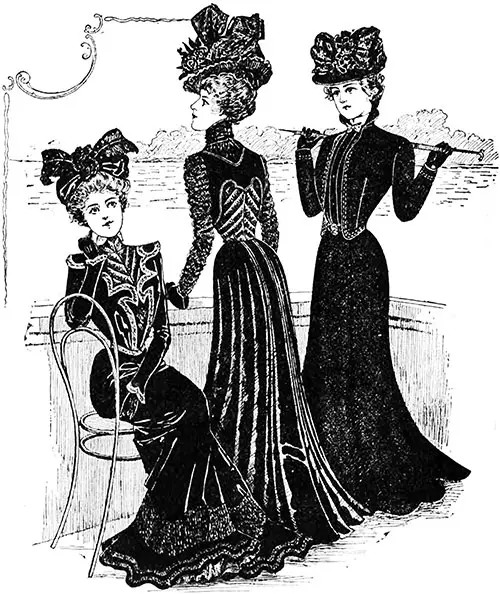
(Above Left) This Charming Costume Represents a Fancy Basque-Waist and Circular Skirt Shaped in Points and Extended by a Circular Flounce. (Above Center) This Costume Is Developed From French Foulé and Crape, With Tiny Bias Folds of Crape As Its Only Ornamental Features. (Above Right) Stylish Tailor Suit, Which Is Developed From Cheviot-Serge With a Simple Decoration of Machine-Stitching. | GGA Image ID # 2178245856
Above Left: Crepe de Chine and crape are tastefully combined in the costume. The waist fronts are full at the bottom, meet at the bust, and are cut away below to reveal a full vest of crape and above to show a yoke of crape tucked.
They are fancifully shaped at the shoulders, extending over the tops of the sleeves. The circular skirt is pointed at the bottom, where a circular flounce lengthens it.
Above Center: There is a full yoke of crape, and below the fancifully shaped bolero of cloth, a deep Robes Pierre girdle mitered at the back is prettily revealed. The collar is odd and has an inside section pointed at the back.
The mousquetaire sleeves are completed with flare cuffs of the cloth. Tucks are introduced in the skirt with a unique and graceful effect, further emphasized by the double-box plaited gore at the back.
Above Right: The stylish Eton jacket's open fronts are slightly rolled at the top, and a high, flaring collar completes the neck. The sleeves are close-fitting. The skirt is a new five-gored mode, and tucks or an underlying box plait may secure the fullness at the back.
A shirtwaist of dull-finished black taffeta, Indian silk, or peau de soie would suit this outdoor costume.
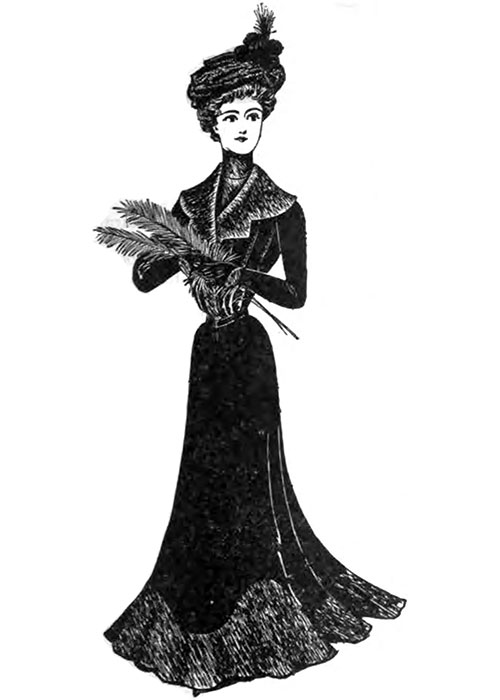
The Association of Crape With a Silk-And-Wool Nun’s Vailing in This Street Costume Is Admirable. A Fancy Collar With Long, Tapering Ends and Stitched Plaits Are the Distinguishing Features of the Attractive Waist, Which Pouches Slightly. The Delineator, June 1900. | GGA Image ID # 21781bf83d
Above: The blouse is cut out at the top to disclose in a V, affecting the smooth chemisette, and circular cuffs give a final touch to the shapely two-seam sleeves. A circular flounce of crape lengthens the circular skirt, and the full-length gore at the back may be laid in a box plait or tucked at the top, as preferred.
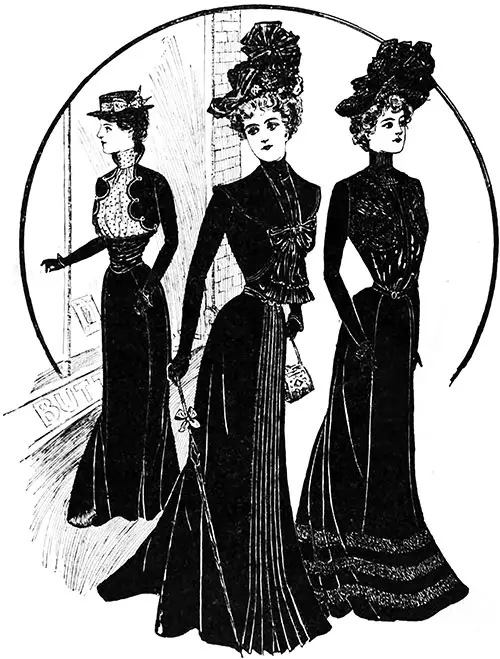
Three Mourning Costumes. (Above Left) This Attractive Costume Was Developed From a Lightweight Cheviot Associated With White Black-Dotted Indian Silk and Peau de Soie, Narrow Braid, and Machine Stitching Furnishing the Decoration. (Above Center) the Stylish Blouse With Fancy Bolero in This Street Costume. (Above Right) Soft Henrietta Cloth and Crape Are Associated With This Costume. The Delineator, June 1900. | GGA Image ID # 2177fa3249
Above Left: Eudora cloth and soft, dull-finished silk are chosen for the mode, with machine-stitching and silk folds as the ornamental features.
Above Center: The bolero's deep shawl collar and close-fitting sleeves extend over the hand in a point. The pouching fronts and high-stock collar are also made of silk, and the scarf, gracefully tied in front, is made of the same soft textile.
The ingenious arrangement of side plaits gives the impression of a one-piece skirt at the front and a triple box plait at the back. The fanciful bolero adds an air of distinction to the basque waist, and the Robespierre belt of peau de soie and a full vest of dotted silk further enhance its attractiveness.
The under-box plait at the lower part of each seam at the front and sides and the box-plaited gore at the back give the skirt character and grace.
Above Right: The fanciful bolero gives added dressiness to the basque waist, which is made with a shallow yoke and finished with a stock and fancy flare cuffs. The five-gored skirt is decorated with three bands of crape.
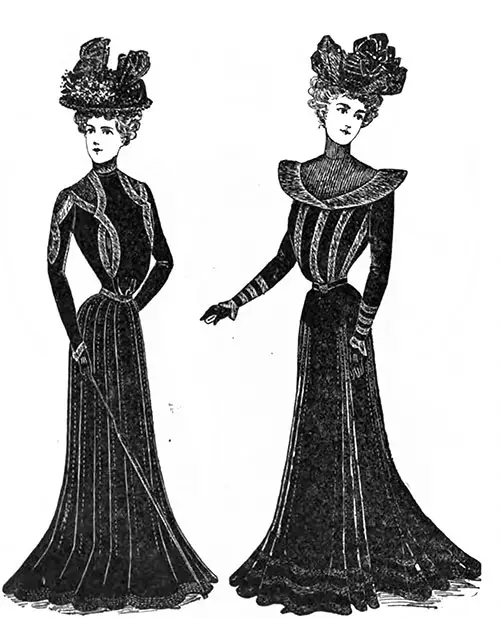
(Above Left) Extreme Grace Characterizes the Costume, Which Represents a Tasteful Combination of Henrietta and Crape, With a Useful Decoration of Machine Stitching. the Blouse’s Shape Is Decidedly Unique but Attractive. (Above Right) This Modish Costume Embodies a Becoming Basque Waist and Skirt. The Delineator, June 1900. | GGA Image ID # 2177dce21c
Above Left: The fancifully shaped center front extends to the back at the neck, and the stretched back is cut low to reveal a smooth, round yoke of crape. Both the center front and side fronts are cut away, exposing the full fronts of crape. The sleeves are distinguished by a cap-facing crape outlined with a narrow band of crape.
The skirt is cut circular and tucked at the front and sides, the tucks terminating a short distance from the bottom.
Louisine, a dull-finished, luxurious, silky fabric, and crape were combined effectively in the costume, with bands of crape and machine-stitching for trimming.
Above Right: The blouse's fichu bertha and deep, smooth yoke are especially noticeable. The yoke and high stock collar are made of crape, finely tucked or plaited, and a bertha outlines the yoke. Scalloped flare cuffs complete the close-fitting sleeves of this costume.
Clusters of tucks below yoke depth characterize the novel skirt. The pleats terminate at flounce depth, and an under-folded double box plait appears at the back.
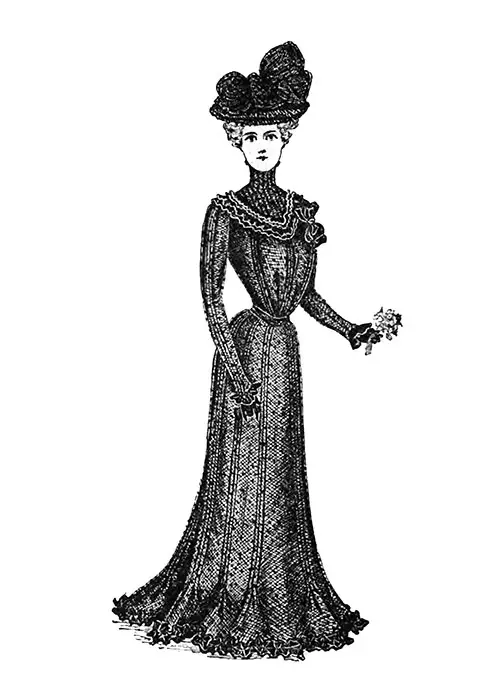
Figure No. 10 an Exquisite Mourning Costume. The Delineator, June 1900. | GGA Image ID # 2177954e05
Figure 10 Above: The gown was developed using a coarse dotted net over dull-finished taffeta decorated with dull-black ribbon. The blouse pouches are in front and stylishly tucked. A round yoke emphasizes the back, while the yoke is pointed in front.
The net is finely tucked to form both the yoke and stock collar. The two-seam sleeve displays a lengthwise cluster of tucks, and a ruffle of ribbon gives completion at the wrists. A soft belt of a ribbon is worn around the waist.
The circular skirt is distinguished by clusters of delicate tucks extending from the belt to within a short distance of the lower edge.
Based on the Article "Mourning Fashions Etiquette," in The Delineator: For Town and Country Issue, Paris-London-New York: The Butterick Publishing Co., Ltd., Vol. LV, No. 6. June 1900, p. 822-824.
